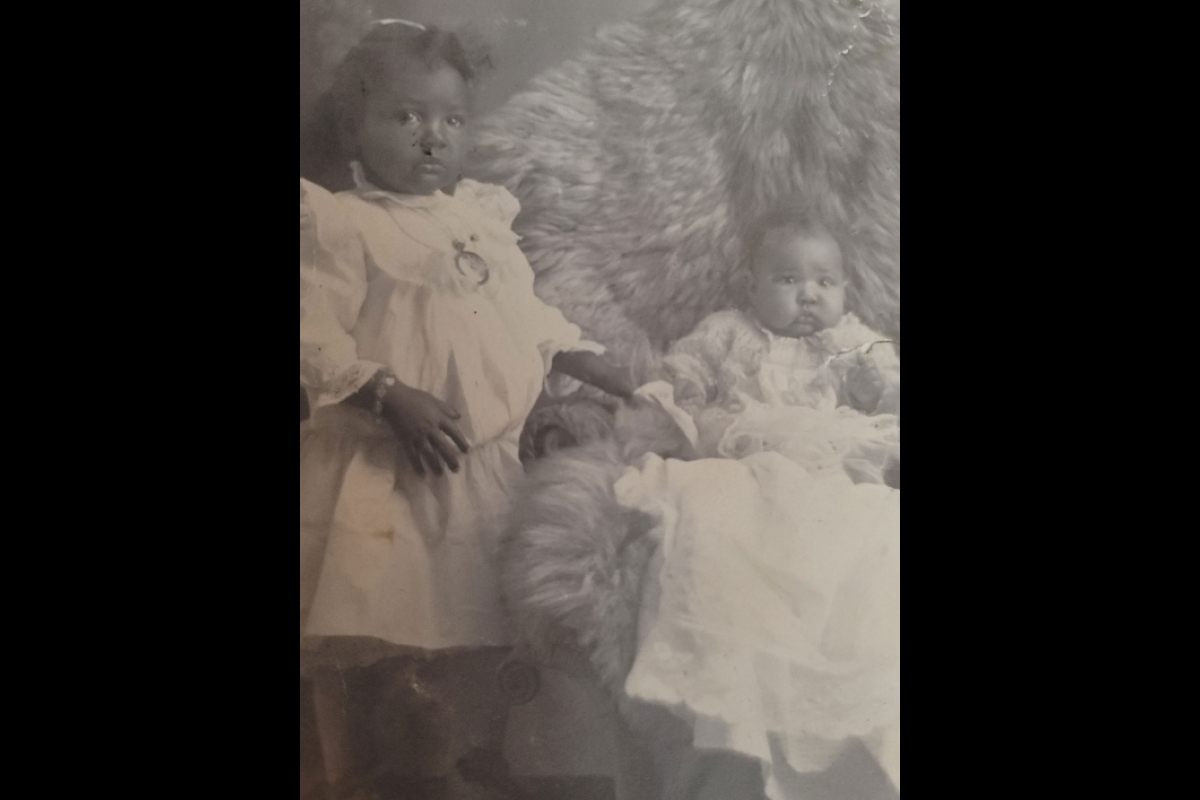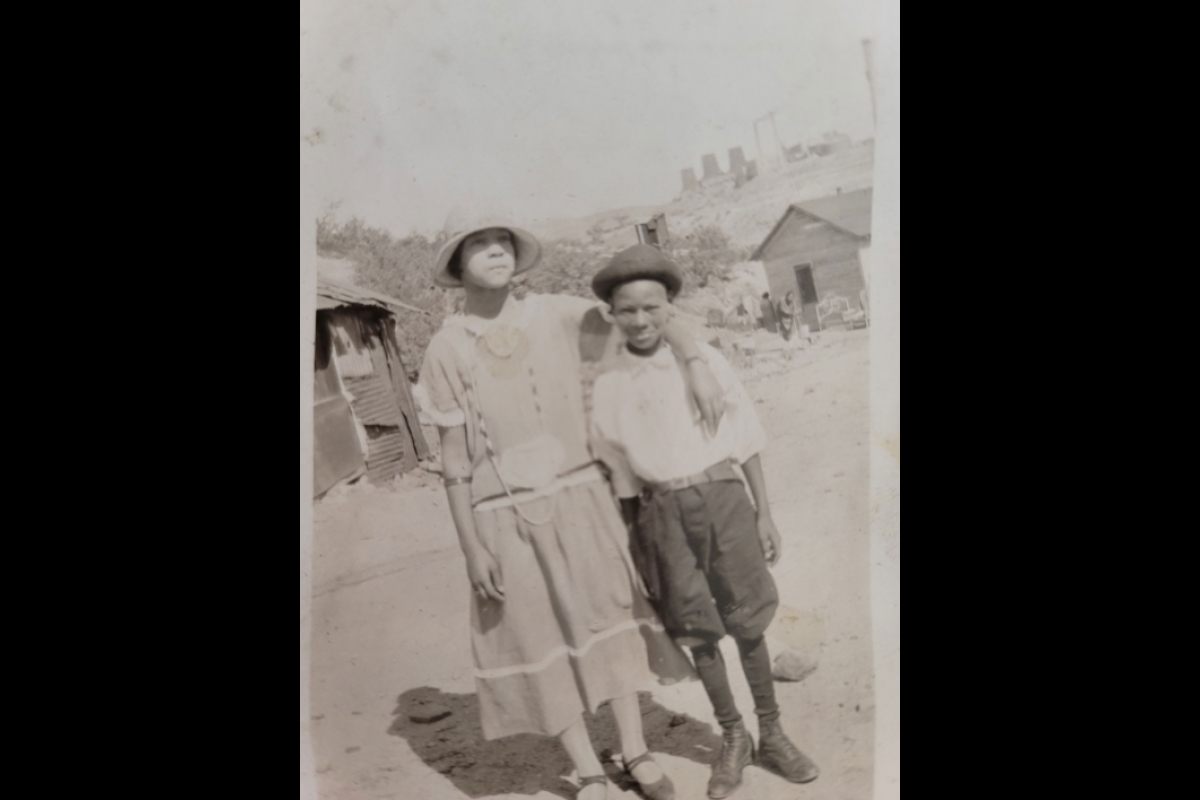Photo album sparks discovery of ASU's first female African American graduate

Stella McHenry's portrait in a family photo album. Photo courtesy of Michele Neptune McHenry and Joseph McHenry
Editor’s note: This story is featured in the 2022 year in review.
Michele Neptune McHenry and her husband, Joseph McHenry, were slowly making their way through the photo album when they came upon the photos and name card.
The card, gray in tone, was about 1-by-2 inches. On it was a name: Miss Stella McHenry.
To the left of the card was a photo of a pensive woman, white pearls hung around her neck.
They turned the page and saw the other photos: The woman sitting on a piece of heavy equipment in Miami, Arizona, in 1923; standing, her arm draped around her brother, Lawrence, in 1925; as an infant, with older sister, Luisa, sometime between August 1904 and December 1905.
They were unsure who this young woman was or how she fit into the family on Joseph’s side.
Their curiosity would lead to a genealogy project and then to an archivist at Arizona State University’s Hayden Library. It would lead to records that were incorrect, to a young girl from Clifton High School who became a teacher and, as it turned out, was the first African American female graduate from ASU.
This is a story of discovery.
This is the story of Estella Rochelle McHenry, better known as Stella.
Family roots
Joseph McHenry didn’t know much about his father’s side of the family. His father passed away when Joseph was 3 years old, and his mother didn’t stay in close touch with her husband’s relatives. But after Michele and Joseph moved back to Arizona in 2011, where he had been born and raised, they decided it was time to learn more about the McHenry name.
They believed the portrait of Stella was a graduation picture but couldn’t be sure. There was no reference to a school, no indication of when she might have graduated.
“It was part of the curiosity,” Michele said. “We didn’t know who she was or how she fit in.”
They began a genealogy project. Slowly, the pieces of the puzzle began to connect. Stella’s father worked as a smelter operator in the copper mines in Clifton. Stella, born in August of 1904, was the second oldest child behind Luisa, who died at the age of 15 from tuberculosis. Joseph’s father, Lawrence, was the youngest. They attended the Colored School in Clifton.
Stella, it turned out, was Joseph’s aunt.
Years passed. Joseph died in 2019. Then, one day, for no particular reason, Michele began searching Stella’s name on the internet and found a reference to her in a book titled “The African American Experience in Tempe.”
An excerpt from the book read:
Among the students who leased cottages from the Thomas’ was Stella McHenry of Clifton, Arizona. Reportedly the first African American woman to graduate from the Arizona State Teachers College in Tempe, Ms. McHenry graduated from the teachers’ program with honors in the Class of 1926 (sic 1925). 'Mother' Thomas developed close ties with Ms. McHenry. In February 1928, Maggie Thomas was called to Phoenix when she learned that the young teacher had passed away.
Stella was an ASU graduate? Michele was intrigued.
“Apparently, they were talking about an early boarding house, because African American students weren’t allowed to stay in the dorms back then,” Michele said.
She sent an email to ASU’s Black Alumni Chapter website asking for more information. Then, she began digging through ASU’s various webpages and came upon the ASU “Firsts” page on the ASU Library website. The page listed Love Hatton Jordan as the first female African American graduate, in 1928.
Michele knew that couldn’t be accurate. Stella’s death certificate — she passed away on Feb. 5, 1928, at the age of 23 of complications from influenza and pneumonia — said she had been a schoolteacher, which required a two-year curriculum that resulted in a “certificate of eligibility” to teach. She found the “Ask an Archivist” section of the library website and asked online when Stella had graduated.
The return email said 1925.
Digging through history
Shannon Walker wanted to learn more.
Walker oversees the University Archives and the archival collections at Thunderbird School of Global Management. When Walker learned Stella was indeed the first female African American graduate at ASU, she hoped to put a story to the statistic and make sure history noted Stella's accomplishment.
“We wanted to make sure she was recognized as a person and not just a number or a statistic,” Walker said. “A fully realized person whose life was tragically cut short. Plus, I think just to be able to be more accurate in our timeline and history is very exciting. Just because it’s history doesn’t mean it’s dead and gone. It’s important to study it and get it right.”
Technology has made the job of an archivist much easier than it was, say, 25 years ago, when the search for a person’s background would involve a trip to the library and hours upon hours of examining microfiche.
The Arizona State Library has digitized versions of local newspapers dating back to the 1860s as part of the Arizona Memory Project. Walker searched for Stella's name in the Copper Era, the name of the newspaper serving Clifton, and discovered that Stella had won an award for being an outstanding student in the fifth grade and sold Victory Girls war bonds, which were used to support the American military in World War I.
“By all respects, she was an amazing student,” Walker said.
Walker couldn’t find details of Stella's time at ASU. Her picture was in the 1925 yearbook, but she wasn’t listed in any clubs or activities or as having stayed in a dormitory, which may have been a reflection of the times. Nor could she confirm that Stella's siblings went to ASU, although both she and Michele believe that to be the case.
Stella McHenry
As she dove into Stella’s background, Walker reached out to Jessica Salow, the assistant archivist and curator of Black Collections at ASU.
“Are you interested in learning more?” Walker asked.
“Yes, please,” Salow responded.
Archiving is not a perfect science. Walker said Stella's omission likely was a human error, someone simply missing her as they browsed through ASU’s yearbooks for “firsts.” And while it wasn’t the case for Stella, the history of people of color is not always easily accessible.
“Black history can be hidden,” Salow said. “So many people that I have run across in Arizona who live in the Black community who have Black family members that have been here for generations, they know about the history of either their community, their family or their people. It’s just that no institution was really interested in a lot of this particular history.
“And when people bring that to us, that means we’re engaging with the community. And we’re doing that work to say, ‘Hey, community, reach out to us.’”
Salow also loved the mystery of trying to discover who Stella McHenry was.
“This is why I got into this particular profession,” she said. “It feels like you’re solving a puzzle.”
Video by Ken Fagan/ASU News
Unfortunately, Stella’s puzzle isn’t complete. She’s listed in the Arizona Educational Directory of 1925–26 and 1926–27 as teaching seventh grade at the Douglas School for Colored Students, making $150 a month.
But who she was as a young woman, how she carried herself, her passions and interests — those remain a mystery.
There is one thing Michele is certain about, though: The same characteristic that led her husband, Joseph, to be a helicopter pilot in Vietnam — one of approximately 600 Black helicopter pilots out of the more than 40,000 helicopter pilots that served in that arena — led Stella to get on a train, leave Clifton and embrace a college education.
Courage.
“He was just always a trailblazer,” Michele said. “So, it just kind of synced up. Here’s another trailblazer in the family.”
More Arts, humanities and education

Local traffic boxes get a colorful makeover
A team of Arizona State University students recently helped transform bland, beige traffic boxes in Chandler into colorful works of public art. “It’s amazing,” said ASU student Sarai…

2 ASU professors, alumnus named 2025 Guggenheim Fellows
Two Arizona State University professors and a university alumnus have been named 2025 Guggenheim Fellows.Regents Professor Sir Jonathan Bate, English Professor of Practice Larissa Fasthorse and…

No argument: ASU-led project improves high school students' writing skills
Students in the freshman English class at Phoenix Trevor G. Browne High School often pop the question to teacher Rocio Rivas.No, not that one.This one:“How is this going to help me?”When Rivas…





